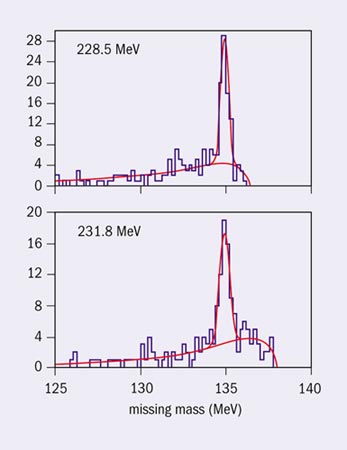Two separate experiments in North America – at TRIUMF in Vancouver and at the Indiana University Cyclotron Facility (IUCF) in Bloomington – have made new observations of charge symmetry breaking (CSB). The results have brought fresh input to theoretical attempts to determine the different contributions to the phenomenon, including effects due to the mass difference between quarks.
If charge symmetry were an exact symmetry, neutrons and protons would be indistinguishable except for their electromagnetic interactions. CSB, which can be attributed to a difference in the masses of u and d quarks and their electromagnetic interactions within the nucleon, is seen in small effects such as the neutron-proton mass difference ΔN. The two new measurements have extended the observation of CSB to pion-production reactions in systems of few nucleons that consist of equal numbers of neutrons and protons.

The group working at TRIUMF, an Alberta-Ohio-TRIUMF-UNBC collaboration led by Allena Opper of Ohio University, measured the angular distribution of deuterons from a reaction in which a neutron and a proton combine to produce a deuteron and a neutral pion (np→dπ0). CSB was expected to appear as a small difference in the numbers of deuterons emitted in the forward and backward hemispheres of the centre-of-mass system. At a neutron beam energy of 279.5 MeV (~ 0.8 MeV FWHM), just 4 MeV above threshold, the deuterons emerged within 30 mrad (lab angle) of the beam direction. This made it possible to detect the complete centre-of-mass angular distribution with one field setting of the SASP magnetic spectrometer. The experiment accumulated more than 6 million good events during 10 cycles of production and calibration runs. The observed events were compared with simulated events to account for energy loss and multiple scattering of deuterons in the liquid-hydrogen target, and the spectrometer’s acceptance.
The results can be expressed in terms of the difference in the numbers of deuterons in the forward and backward hemispheres divided by their sum: Afb = 17±8(stat)±5.5(sys) x 10-4. For comparison, a theoretical calculation of Afb identified contributions from the n-p mass difference, from η-π mixing, and from π0 rescattering effects, which are due to the d-u quark mass difference and electromagnetic interactions between the quarks (J A Niskanen 1999, U van Kolck et al. 2000). The solid blue line of figure 1 indicates the shift in the calculated value of Afb when a “large but still reasonable” value for π0 rescattering is included. To reconcile this prediction with the data for Afb and the neutron-proton mass difference would require a quark mass difference within the chiral effective field theory that is less than 2 MeV. Large uncertainties remain, however, because neither the strength of η-π0 mixing nor the η-N coupling is well known.

The IUCF-Argonne-Hillsdale-Minnesota State-Western Michigan collaboration, led by Edward Stephenson, sought evidence for the reaction in which two deuterons combine to form an alpha particle and a neutral pion (dd→απ0). This reaction is forbidden by charge symmetry, so a non-zero cross section would indicate CSB. The group’s method was to make deuterons circulating in the IUCF Cooler Ring collide with deuterons in a gas jet target, and then detect the resulting alpha particles in coincidence with the two gamma rays from the decay of the neutral pion. The challenge was to see a clean signal for the reaction – estimated to be as small as a few picobarns in cross section – in the presence of various backgrounds. The most troublesome background was expected to come from a reaction producing an alpha particle and two gamma rays, but without the formation of a pion – a reaction that is not forbidden by charge symmetry. The IUCF group was able to display the αγγ events in terms of the missing mass, showing a clear peak at the mass of the pion on top of the double radiative capture continuum (figure 2). The cross section measured was 12.7±2.2 picobarns at a beam energy of 228.5 MeV and 15.1±3.1 pb at 231.8 MeV.
This non-zero result has provided fresh stimulus to a team of theorists whose goal is to relate the dd→απ0 cross section, thought to be dominated by η-π mixing, to quark mass differences. The hope is that this cross section, when combined with the n-p mass difference and Afb in np→dπ0, will help unravel the quark mass difference, electromagnetic and meson-mixing contributions to nuclear CSB.
These results and the related theoretical work were the focus of a special session of the April 2003 meeting of the American Physical Society in Philadelphia.
Further reading
J A Niskanen 1999 Few-Body Systems 26 214.
U van Kolck, J A Niskanen and G A Miller 2000 Phys. Lett. B493 65.
http://www.physics.arizona.edu/~vankolck/coolerCSBtheory.html.





